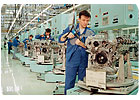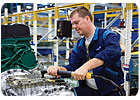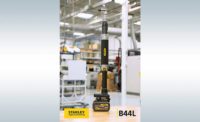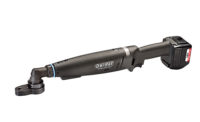
Back in the day, the tightness of a nut or bolt was largely a matter of the operator’s judgment. An assembler might put his hand on the socket and feel it slowing down. Or, he might judge a fastener tight enough when a washer started to bend.
On today’s assembly line, with its transducerized, computer-controlled fastening tools, such comments are nothing less than heresy. The whole idea of using an automatic shut-off tool, whether pneumatic or electric, is to eliminate that interpretation by each individual operator. The goal is to make the process foolproof.
Assemblers have invested considerable sums in high-tech fastening tools during the past few years. These tools measure torque and angle, count the number of fasteners that have been tightened, and even direct the operator to each fastening location. However, even tools equipped with a slew of error-proofing technology can still be used incorrectly. To ensure quality control---and protect the safety of their workers---supervisors need to train operators how to use fastening tools correctly.

Dos and Don'ts
When tightening a fastener, the driveshaft of the tool should be perpendicular to the work surface, and the center line of the driveshaft should be aligned with the center line of the fastener.
The best way to hold a tool depends on its configuration. For pistol-grip and in-line tools, the workpiece should be positioned so the tool can be held with one hand at waist height, with the shoulders squared and the arm slightly bent. If the tool will apply more than 10 newton-meters of torque, it should be mounted on a support arm. A right-angle tool should be operated with two hands. One hand should be near the head of the tool; the other should be at the base of the handle.
Pistol tools are generally applied to horizontal applications at lower torques, in-line tools are for vertical applications, and angle nutrunners can be used for both. In all cases, the tool must be held firmly. If the operator lets the tool spin or wobble excessively, this will have a detrimental effect on both comfort and torque accuracy.
Regardless of the configuration, fingers should be kept away from rotating parts and pinch points. Operators should avoid using a tool over their shoulders or reaching to tighten a fastener.
Knowing when a fastener has been tightened correctly depends on the tool. Stall tools have a clutch that ratchets at a preset torque. “A stall tool stops when you let go of the trigger,” says Andre Melis, director of sales at Apex Tool Group. “The more you hold on, the more force is applied to the fastener. For ergonomic reasons, operators don’t want to hold onto the trigger too long, so they tend to stop prematurely and torque accuracy is all over the map.”
Shut-off tools stop automatically when a preset torque is reached. These tools also provide visual and audible signals when a fastener has been tightened correctly. For example, many tools have LEDs in their handles. Green LEDs illuminate when fasteners are tightened correctly; red ones light up when they aren’t. Other tools can signal to a light-stack or video monitor to tell the operator that the joint was good or bad.
Technology can also alert operators when the tools themselves aren’t functioning correctly. For example, cordless tools from Makita are equipped with voltage sensors that shut off the tools when battery capacity drops below 5 percent. The tool won’t operate if the battery does not have enough power to apply the required torque, even if there’s enough juice to turn the motor. A flashing LED warns the operator when battery capacity is close to the 5 percent limit.
Similarly, the controller for a DC electric tool monitors the electrical performance of the motor and tracks how many hours the tool has run. If problems occur, the controller will shut down the tool and alert maintenance personnel. A pneumatic tool can be paired with a controller that monitors and regulates air pressure. The device will alert the operator if there’s not enough air pressure to run the tool.
Electronic error-proofing technology doesn’t necessarily prevent errors. In most cases, it merely alerts the operator to the fact that a fault has occurred. The operator must still correct the error or alert a supervisor that something is amiss.
Ironically, technology can play a role here, too. For example, a computer-controlled tool can signal a PLC to keep a conveyor from passing an assembly to the next station unless the required number of fasteners have been installed. Similarly, a major tractor manufacturer uses Atlas Copco’s computer-controlled DC electric tools to tighten many critical fasteners. If two consecutive faults occur at an individual station, the tool locks up and a supervisor must investigate the cause of the problem, explains Melis. After taking corrective action, the supervisor unlocks the tool by scanning his badge with the controller’s bar code reader.
Error-proofing doesn’t have to be high-tech. Drawings, photographs and even videos can be displayed at assembly stations to show operators where to install fasteners or the order in which to install them. Fasteners for different assemblies or fastening locations can be stored in color-coded bins. In the aerospace industry, bolts for jet engine assemblies are supplied in plastic trays-each bolt has its own pocket in the tray. Thus, an operator can tell at a glance if every fastener for the assembly has been installed.
As powerful as error-proofing technology and methods can be, they don’t obviate the need for thorough training. Training makes all the difference. Operators are often working at a very hectic pace. If they are not trained in techniques and basic fastening strategy, they can easily miss an obvious joint failure. With air tools, the only way to determine if a fastener is correctly tightened is by feel. Seasoned operators know if the tool shut off correctly or if it stalled. Operators who are poorly trained might think they are tightening everything right, but they may let hundreds of incorrect joints out the door before someone notices.
This issue is less of a concern with DC electric or cordless tools, because the tools provide feedback in the form of lights and tones. This certainly does not mean that all screws tightened by these tools will be perfect. Operators must know what those lights and tones are telling them.
What’s more, operators can ignore or even subvert error-proofing technology. On one assembly line, an operator kept a “simulated joint” on a work cart. Attempting to work ahead of the line rate, the operator would use the fake joint to trick the error-proofing routine programmed into the tool and thus avoid stopping the line.
Such stories underscore the importance of adequate training. A well-trained operator who takes pride in contributing to the assembly process is still the best insurance against errors.
Training operators to use power tools is more complicated than simply showing them how to pull the trigger, says a training manager at power tool supplier AIMCO. Supervisors must understand the line conditions and vary their training depending on the production rate, access to the assembly, the type of tool, and the workers’ level of experience.
“For example, I once instructed a manufacturing engineer how to use an angle nutrunner, but all the training was done in the tool crib,” the manager recalls. “Soon after, the engineer called to say the tool was not accurately delivering torque. When I checked on the problem, I found that the way I had shown him to use the tool wouldn’t work with his particular assembly. Because of limited access to the part, the operator would anticipate the torque reaction and prematurely stop running the tool. By working with the operator to find a better working position, the problem was solved.”

Training System Combines Electronic, Hands-on Learning
Using computer-based lessons, real fastening tools and sample assemblies, a new training system teaches workers how to tighten joints safely and accurately.
The system was developed by Amatrol Inc., a company that specializes in equipment- and computer-based technical and vocational training for high school students, college students and industrial workers.
The system consists of eight modules: torque basics, torque-controlled tools, O-ring seals, lip seals, hydraulic fittings, hose and coupling assembly, hose installation, and tubing installation. Each module is di-vided into three to five segments, and each segment teaches several objectives and skills. The lessons use text, images and video to demonstrate how to operate various fastening tools and how to install various threaded components, such as hydraulic fittings and zerks.
For example, the module on torque-controlled tools covers pneumatic pulse tools, electric direct-drive tools, computer-controlled DC electric tools, stall bars, and torque wrench applications. After completing the segment on pulse tools, operators should know how a pulse tool operates, how to inspect the tool, and how to use the tool to tighten a threaded fastener.
The modules are uploaded to a central server, so workers can access the lessons anytime and anywhere via an Internet connection.
A key aspect of the system is that workers can immediately try what they’ve learned on a custom-made training center. The center can be equipped with sample assemblies and a variety of fastening tools, from manual torque wrenches to DC electric nutrunners. Through sensors and computers, the center can tell workers if they are using the tools correctly. Safeguards prevent novices from breaking tools or stripping tapped holes.
“Each module takes an average learner 3 to 5 hours to complete,” says Joe Reid, vice president of Amatrol. “We believe you should learn a little, then practice, learn a bit more, then practice that. It’s the best way to retain what you learn.”
The system was originally developed for Caterpillar Inc., but the modules and the training center can be customized to meet the needs of any assembly operation. For example, if assemblers are having difficulty installing bolts at a difficult angle, the training center can be equipped with a sample assembly that duplicates that position.
For more information, call Amatrol at 800-264-8285 or visit www.amatrol.com.



